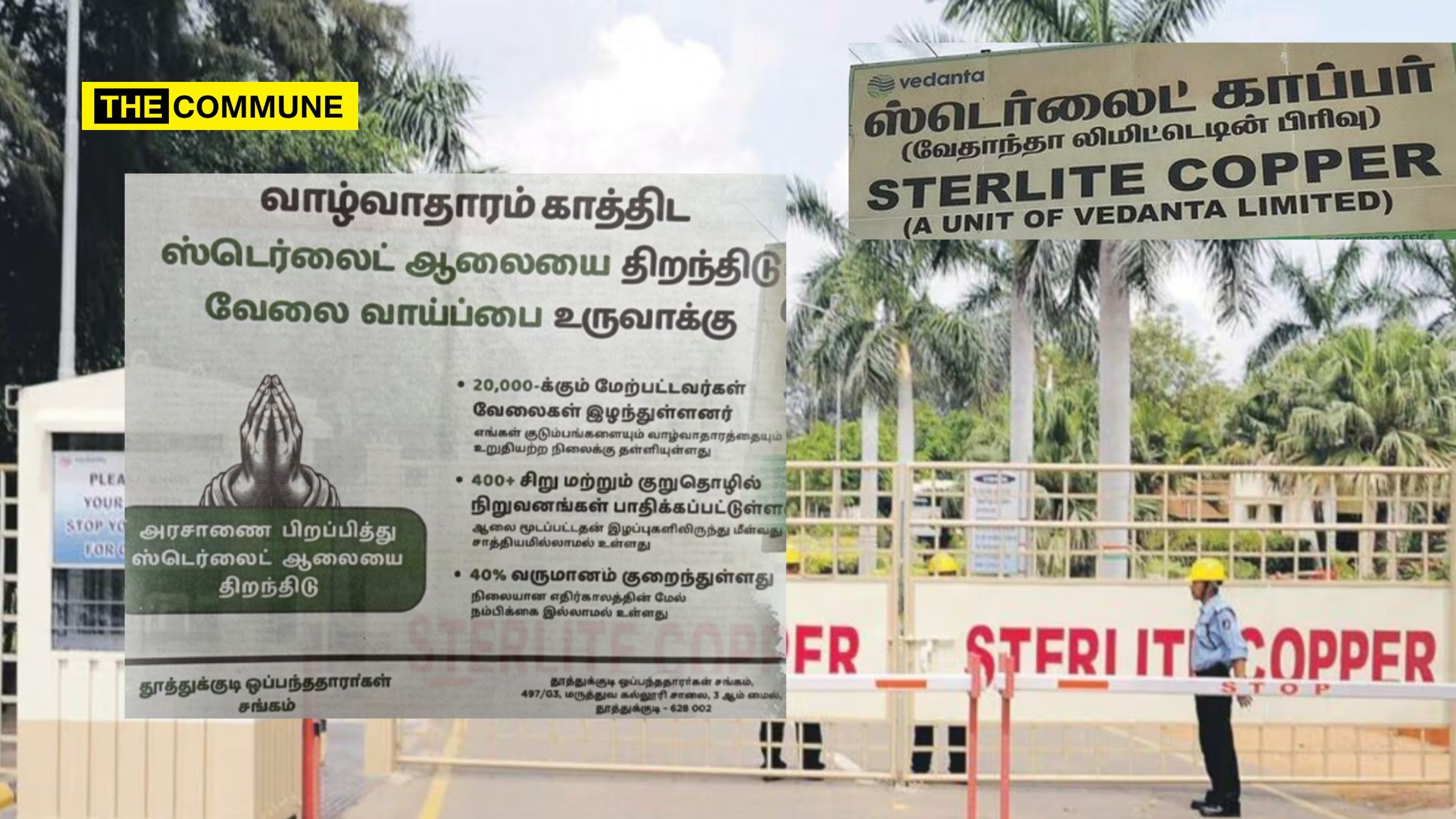
Following calls from the INTUC, Namakkal Lorry Owners’ Association, and Namakkal Trailer Owners’ Association, the Thoothukudi Contractors’ Association has now urged for the reopening of the Sterlite Vedanta copper smelting plant, which was shut down in 2018.
In a statement, they highlighted that the plant’s closure led to the loss of 20,000 jobs and severely impacted 400 small and medium-sized enterprises (SMEs), with income levels dropping by 40%. They have called on the government to issue a Government Order and reopen the plant. Just a month ago, employees had also voiced their demand for its reopening.
மீண்டும் ஸ்டெர்லைட்..! #NewsUpdate#Sterlite #thutthukudi #TamilJanam pic.twitter.com/0e8UmTtwi8
— Tamil Janam (@TamilJanamNews) January 31, 2025
Previously, on 6 January 2024, the Namakkal Lorry Owners’ Association and Namakkal Trailer Owners’ Association organized a protest to highlight the severe economic impacts faced by the freight and logistics sector due to the closure of the Sterlite Copper plant in Thoothukudi. The truck community in Namakkal had been vital to the plant’s operations, supplying trucks and trailers during its years of activity. The plant was shut down in 2018 after sustained protests from local residents, concerned about pollution and its harmful health effects on the surrounding areas.
The closure of the copper smelting plant has had far-reaching effects on the local economy, with the transport sector and the livelihoods of thousands of families suffering. Around 6,500 trucks were linked to the plant’s operations, and more than 600 lorry owners have been forced to shift to driving, exacerbating unemployment. The shutdown has caused a daily economic loss of over ₹10 crore, leading to financial instability and increased debt for many families. The protest, with 500 participants, highlighted the struggles of workers, business owners, and their families who are facing dwindling opportunities and rising operating costs. The demonstrators called for the reopening of the plant under strict environmental supervision, suggesting that advanced emission control technologies be implemented to minimize environmental damage.
Similarly, on 20 December 2024, the Indian National Trade Union Congress (INTUC) held a protest in Chidambaranagar, urging the state government to reopen the Sterlite Copper plant and create more employment opportunities in the region. Over 500 people participated in the demonstration, with INTUC Working President Kathirvel leading the call for the plant’s reopening. Protesters demanded special legislation to allow the facility’s revival, which was shut down following Supreme Court orders.
Kathirvel, who also serves as the General Secretary of the National Harbour Workers’ Union and a trustee of the VOC Port Trust, emphasized that the closure of Sterlite Copper and other industries had harmed Thoothukudi’s socio-economic development and employment prospects. He pointed out that automation at VOC Port had displaced 7,000 manual laborers, while the reduction in salt pan areas had affected women’s employment. He also warned that the plant’s permanent closure would result in India becoming a net importer of copper after 18 years and cause significant job losses, including 3,000 truck drivers and 4,000 daily wage laborers. Kathirvel supported MP Kanimozhi’s appeal for new industries in the region, including semiconductor manufacturing units, but urged the government to reconsider reopening the copper plant to boost local economic recovery.
Impact Of Sterlite Copper Plant Closure On Indian Economy
The closure of the Sterlite Copper plant in Thoothukudi, Tamil Nadu, in May 2018 has had significant economic ramifications, with estimates indicating a loss of over ₹14,000 crore to the Indian economy. According to a report by Consumer Unity & Trust Society (CUTS) International, this figure, which translates to nearly $2 billion, reflects the cumulative losses experienced by various stakeholders, including the government, state, ports, and investors. The loss amounts to approximately 0.72% of Tamil Nadu’s State Gross Domestic Product (SGDP) for the four-year period of the plant’s closure.
The closure did not only affect the company, Sterlite Copper, which reportedly faced a loss of ₹4,777 crore, but also had widespread consequences for the Indian economy. While the precise distribution of the company’s losses is unclear, the closure has also resulted in substantial revenue losses for both central and state governments, particularly in terms of taxes and duties. A separate report commissioned by NITI Aayog examined the broader economic impact, which included significant reductions in tax revenue.
Impact On Copper Production And India’s Trade Balance
Before its closure, Sterlite Copper was responsible for producing 40% of India’s copper. The plant’s shutdown marked a significant shift in India’s copper trade balance, turning the country from a net exporter to a net importer of copper. The closure has had a profound effect on the country’s ability to meet domestic copper demand, with India’s copper exports plummeting by 70% following the plant’s closure. Notably, India, which had been one of the top five copper exporters globally, saw its exports drop dramatically from 378,000 tonnes in 2017–2018 to just 48,000 tonnes in 2018–2019.
China’s Gain And Challenge To India’s Atmanirbhar Bharat
China, a major global player in copper production, emerged as one of the biggest beneficiaries of India’s copper shortage, with its copper exports to India doubling. This shift has been detrimental to India’s Atmanirbhar Bharat initiative, as copper is critical for industries ranging from electricals to automotive manufacturing. With copper demand set to rise due to the growing electric vehicle (EV) market, renewable energy push, and rapid urbanization, India faces significant challenges in meeting its future copper needs.
Rising Copper Demand And India’s Future Needs
As per estimates, copper demand in India is expected to grow by over 9.3% annually, reaching around 2.5–3.5 million metric tons by 2030. This demand will be driven by industries such as renewable energy, electric vehicles, and power grid expansion. For instance, electric vehicles (EVs) require substantial quantities of copper, with each EV car using approximately 83 kg of copper, and EV buses requiring 224 kg. As India aims to achieve 30% EV penetration by 2030, the demand for copper will soar. Additionally, with the government’s focus on increasing solar and wind energy capacity, copper’s role in energy production and transmission will be crucial.
The Shift In Investment: India To Saudi Arabia
The prolonged closure of the Sterlite Copper plant has led Vedanta, the parent company, to reconsider its investment strategy. With repeated denials for reopening the plant, Vedanta has decided to invest in copper projects abroad, particularly in Saudi Arabia. The company has signed a memorandum of understanding (MoU) to invest $2 billion in establishing copper smelting and refining facilities in the country. This shift represents a significant blow to Thoothukudi’s economy and India’s industrial prospects, as Vedanta’s investment in Saudi Arabia is expected to contribute $19 billion to Saudi Arabia’s GDP.
Allegations Of Foreign Influence On Protests
The protests leading to the closure of the Sterlite Copper plant have raised questions about foreign involvement. Allegations have been made that foreign-funded entities, including Chinese companies with vested economic interests in India’s copper imports, played a role in inciting protests against the plant. These protests were reportedly supported by NGOs and other groups that violated the Foreign Contribution Regulation Act (FCRA) by accepting foreign funds, even after their FCRA registrations were canceled. This has further complicated the issue, as it suggests that external influences may have contributed to the economic damage caused by the plant’s shutdown.
Locals are now protesting to reopen Sterlite Copper plant due to job loss
Close to 50,000 people lost their Job after closure of the plant in 2018
India suffered 2 billion revenue loss and become depended on China for copper import for Electric Vehicle and other Green Energy… pic.twitter.com/SbHTjuJDEL
— Hindutva Knight (@HPhobiaWatch) December 23, 2024
Similar to protests seen in other parts of the world, such as the Carmichael coal mine in Australia, opposition to the Sterlite plant was driven by ‘environmental’ concerns. However, the lack of swift resolution by state and national bodies resulted in economic losses for India. The closure of Sterlite Copper, which had been an important part of Thoothukudi’s industrial ecosystem, is seen as a case of missed opportunities for balanced decision-making.
The closure of the Sterlite Copper plant has had far-reaching economic consequences for India, both in terms of lost employment opportunities and reduced copper production. As the country struggles to meet rising copper demand, the closure has shifted the balance of trade, with China and other countries reaping the benefits. Moving forward, India must prioritize the revival of its copper industry to ensure it remains competitive in the global market and meets its growing demand for this essential metal.
Subscribe to our channels on Telegram, WhatsApp, and Instagram and get the best stories of the day delivered to you personally.




